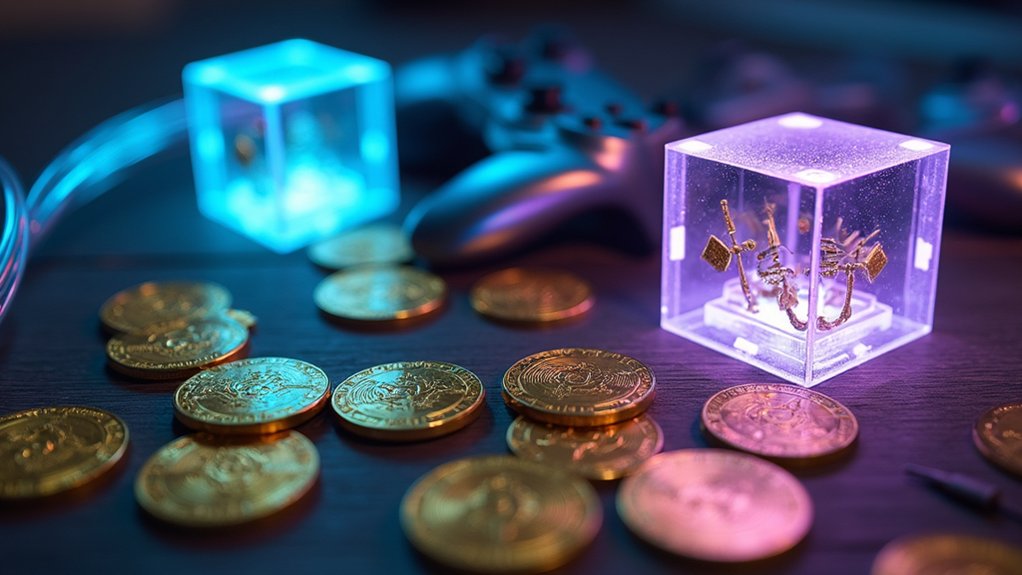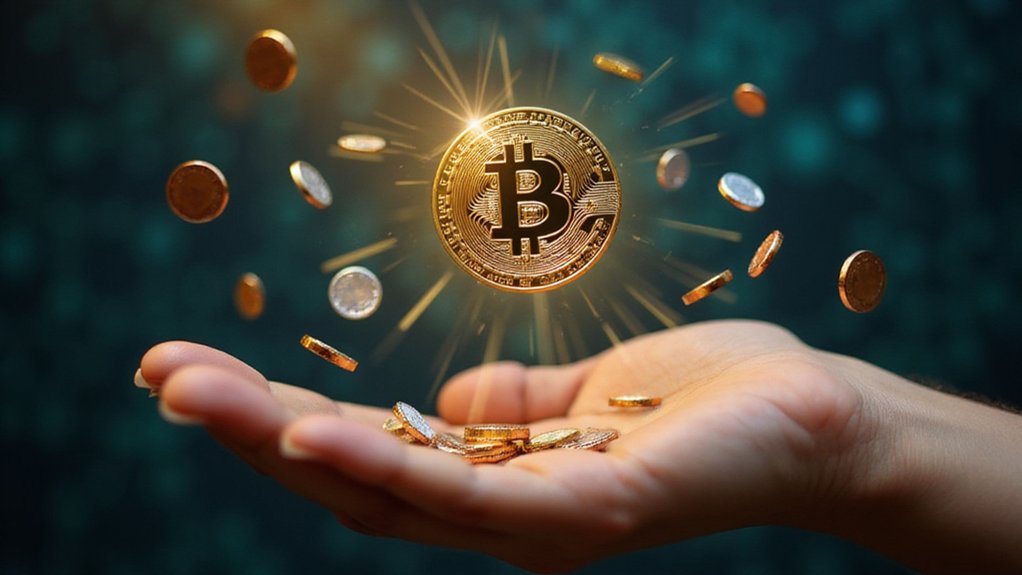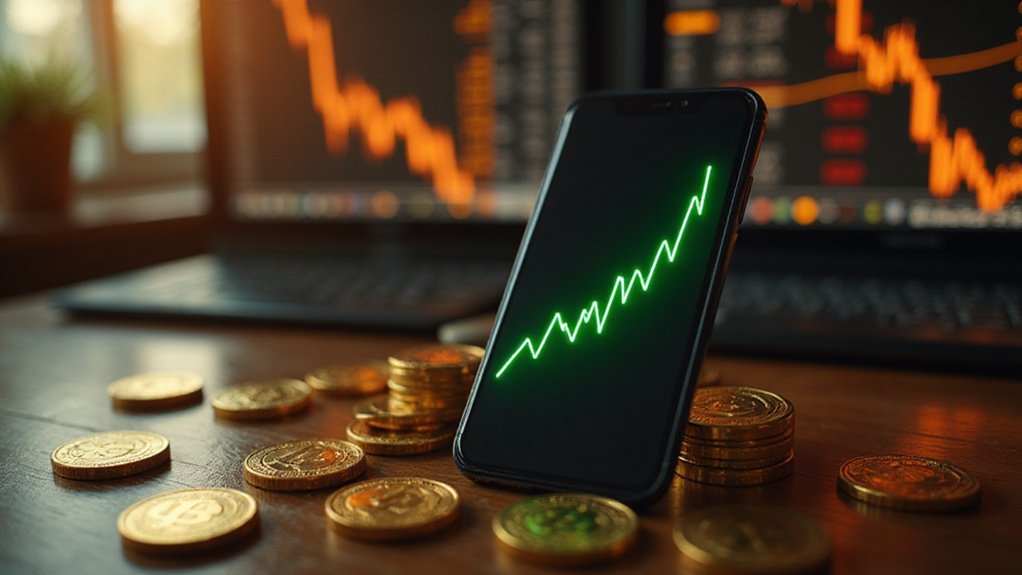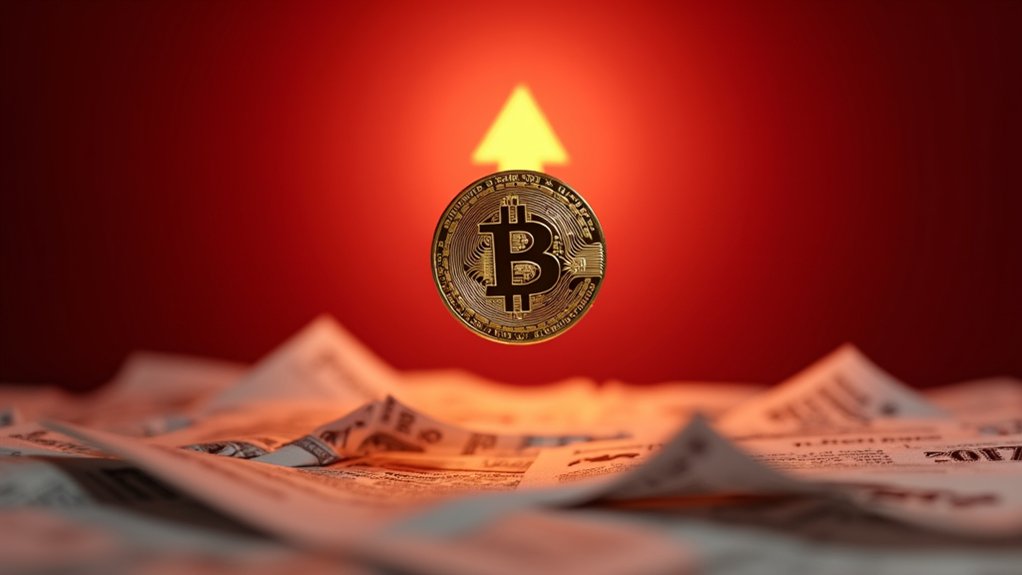Blockchain gaming has transformed from speculative novelty into a $24.4 billion market where players monetize leisure through cryptocurrency rewards and NFT ownership. The play-to-earn model converts virtual achievements into legitimate income streams, particularly appealing to emerging market participants who view gaming as economic opportunity rather than mere entertainment. With projections reaching $1.17 trillion by 2033 (a staggering 62.59% CAGR), this intersection of digital entertainment and financial speculation continues reshaping traditional gaming paradigms through decentralized economies that transcend platform boundaries.

The blockchain gaming market, valued at a modest $24.4 billion in 2025, is projected to explode into a staggering $1.17 trillion behemoth by 2033—a compound annual growth rate of approximately 62.59% that would make even the most optimistic venture capitalist reach for their calculator twice.
This astronomical trajectory reflects more than mere speculative fervor; it signals a fundamental reimagining of how digital entertainment intersects with economic opportunity.
At the heart of this transformation lies the play-to-earn (P2E) model, which has effectively weaponized gaming addiction for financial gain—though whether this represents progress or dystopia remains deliciously ambiguous.
Players in emerging markets particularly embrace these mechanisms, transforming virtual sword-swinging into legitimate income streams while developed-world observers debate the philosophical implications of monetizing leisure time.
Non-fungible tokens (NFTs) serve as the infrastructure backbone, enabling verifiable ownership of digital assets that can traverse gaming platforms with unprecedented fluidity.
These tokens grant in-game items real-world value, creating secondary markets where a legendary sword might command prices rivaling actual steel—a development that would surely perplex medieval blacksmiths.
The cross-platform utility of NFT-backed assets represents a paradigm shift from traditional gaming’s walled gardens toward interconnected digital economies.
Blockchain’s inherent security features provide the technological foundation necessary for these complex transactions, offering transparency and trust mechanisms that traditional gaming platforms struggle to match.
Decentralized platforms increasingly attract both developers and players seeking alternatives to centralized control structures, though regulatory uncertainties continue casting shadows over long-term viability. Poor gameplay concerns affect 37.2% of industry participants, highlighting the ongoing tension between technological innovation and fundamental entertainment value.
The metaverse integration adds another layer of complexity, promising immersive experiences that blur the boundaries between virtual and physical economic activity.
Major technology companies and venture capitalists are pouring capital into these ventures, betting that personalized, immersive gaming experiences will justify the substantial infrastructure investments required. Ethereum maintains its position as the dominant blockchain platform for gaming applications, commanding a 32.05% market share through its robust smart contract capabilities.
Yet challenges persist.
Regulatory frameworks lag behind technological innovation, creating uncertainty for market participants maneuvering evolving compliance landscapes. Trading platforms like OpenSea continue to dominate the NFT marketplace ecosystem where gaming assets are bought and sold, establishing the infrastructure for these emerging digital economies.
Infrastructure limitations and shifting consumer preferences add additional variables to an already complex equation.
Whether this market can sustain its projected growth trajectory or will succumb to the same speculative cycles that plague emerging technologies remains the trillion-dollar question.
Frequently Asked Questions
How Do Gas Fees Affect Small In-Game Transactions and Microtransactions?
Gas fees create a peculiar economic paradox where purchasing a $0.50 digital sword might cost $15 in transaction fees—a mathematical absurdity that renders microtransactions financially nonsensical.
These blockchain processing costs, calculated as (base fee + priority fee) × gas limit, disproportionately burden small-value transfers.
Smart contract interactions compound the problem, effectively pricing out casual players from frequent transactions and undermining the fluid economies that gaming ecosystems desperately need.
Can Players Truly Own NFT Game Assets Across Different Gaming Platforms?
Players can achieve genuine cross-platform NFT ownership through blockchain-based smart contracts and unified wallet systems, though implementation remains frustratingly inconsistent across gaming ecosystems.
While technical infrastructure supports transferable digital assets—enabling that coveted sword from Game A to appear in Game B—the reality depends heavily on developer cooperation and platform policies.
True interoperability requires standardized protocols and, perhaps more critically, gaming companies willing to relinquish their traditional walled-garden revenue models.
What Happens to Virtual Assets if a Blockchain Game Shuts Down?
When blockchain games shutter, players discover the uncomfortable reality behind “true ownership” rhetoric.
While NFT assets technically persist on-chain indefinitely, they become functionally worthless digital artifacts—imagine owning a perfectly preserved deed to a demolished house.
The assets remain in wallets, immutable yet useless, since interoperability between games remains largely theoretical.
Players retain technical ownership of tokens that no longer serve any practical purpose within gaming ecosystems.
Are Blockchain Games Compatible With Traditional Gaming Consoles Like Playstation and Xbox?
Blockchain games are increasingly compatible with traditional consoles, with Gunzilla’s Off The Grid marking PlayStation 5’s first official blockchain integration.
The PS5 Pro‘s enhanced GPU capabilities support these Web3 experiences, though Xbox remains conspicuously absent from the blockchain gaming conversation despite comparable hardware.
The challenge lies in balancing NFT advantages with gameplay fairness—a delicate equilibrium that could determine whether console blockchain gaming becomes mainstream or remains niche.
How Do Tax Implications Work for Earning Cryptocurrency Through Gaming?
Cryptocurrency gaming earnings face the IRS’s unforgiving gaze, with token rewards treated as ordinary income at fair market value upon receipt—regardless of subsequent price volatility.
Capital gains taxation applies when selling in-game NFTs or cryptocurrencies, creating a delightful double-taxation scenario.
Players must meticulously track every blockchain transaction (because the government certainly will), reporting everything on Form 1040 while handling tax rates spanning 0% to 37%.









